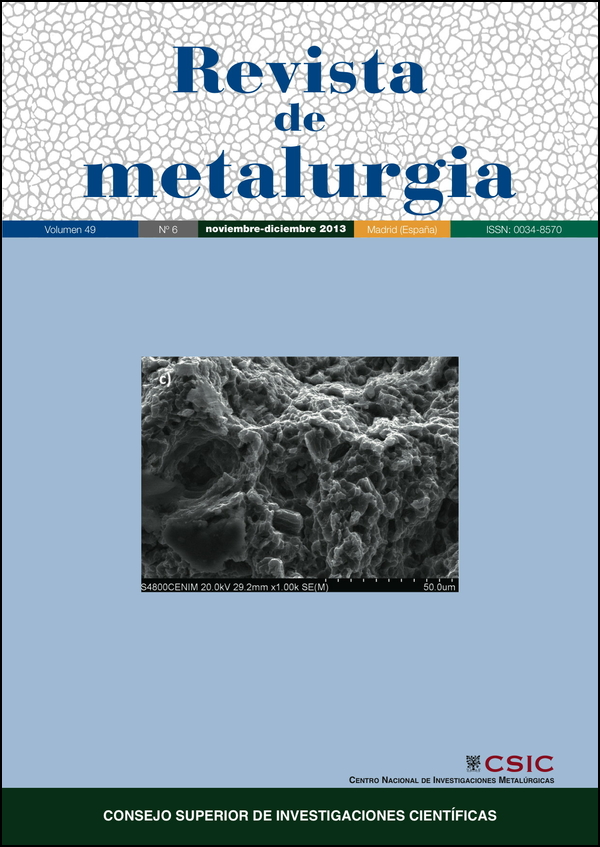Characterization of metallurgical slags from archaeological sites in Navarre (2nd century B.C. through 4th century A.D.)
DOI:
https://doi.org/10.3989/revmetalm.1302Keywords:
Archaeometallurgy, Archaeological sites, Iron, Metallurgical slags, Characterization, 2nd century B.C. through 4th century A.D.Abstract
The Archaeology Section of the Government of Navarre put forward a proposal to undertake research in the characterization of a set of pieces from 2nd century B.C. to 4th century A.D. retrieved from excavations in different archaeological sites in this province, to obtain data related to the manufacturing process of the investigated artefacts and to compare the level of technical skills in different times and places, so as to achieve a better understanding of technological abilities and material culture. The finds discussed in this paper are of interest from an archaeometallurgical point of view, and they consist mainly of metallurgical slags, remains of manufactured pieces, and minerals residues used to obtain various metals. In addition to carrying out their chemical analyses by inductively coupled plasma (ICP), the study of six samples was performed by optical and scanning electron microscopy and energy-dispersive X-ray microanalysis (EDX) which revealed the composition of large areas of the slags, and the study was finally completed by the determination of the phases present by X rays diffraction.
Downloads
References
[1] R.F. Tylecote, A History of Metallurgy, The Institute of Metals, 1st. Ed., Londres, Inglaterra, 1976, pp. 64-80.
[2] P.T. Craddock y M.J. Hughes, Furnaces and Smelting Technology in Antiquity, British Museum (Occ. Papers 48), Londres, Inglaterra, 1985.
[3] P. Gómez -Ramos, Trabajos de prehistoria 1 (1996) 127-143. http://dx.doi.org/10.3989/tp.1996.v53.i1.409
[4] S. Rovira, Archaeometallurgy in Europe, Proceedings, Vol. 1, Associazione italiana di metallurgia, Milán, Italia, 2003, pp. 479-486.
[5] P. Gómez-Ramos, Tesis Doctoral, Facultad de Filosofía y Letras, Universidad Autónoma de Madrid, 1995.
[6] B. Rothenberg, Copper smelting furnaces in the Arabah, Israel: the archaeological evidence, Furnaces and Smelting Technology in Antiquity, P. Craddock y M. Hughes (Eds.), British Museum, Londres, Inglaterra, 1985, pp.123-150.
[7] A. Hauptmann, Archaeometallurgy in Europe, Proceedings, Vol. 1, Associazione italiana di metallurgia, Milán, Italia, 2003, pp. 459-468.
[8] J. Setién y J.A. Díez-Aja, Rev. Metal. 4 (2008) 299-309.
[9] A. Kronz, Archaeometallurgy in Europe, Proceedings, Vol. 1, Associazione italiana di metallurgia, 2003, pp. 555-564.
[10] H. Bachmann, Scientific Studies in Early Mining and Extractive Metallurgy, P. Craddock (Ed.), British Museum, Londres, Inglaterra, 1980, pp.103-134.
[11] V. Serneels y S. Perret, Archaeometallurgy in Europe, Proceedings, Vol. 1, Associazione italiana di metallurgia, Milán, Italia, 2003, pp. 469-478.
[12] J. Armendáriz , De aldeas a ciudades. El poblamiento durante el primer milenio a.C. en Navarra, Gobierno de Navarra, Trabajos de Arqueología Navarra, Monografías Arqueológicas, 2, 2008, pp. 77-80.
[13] G. Rosado y J.C. García, Rev. Metal. (Vol. Extr.) (2005) 101-106.
[14] J. Chen, M. Imamura y R. Han, Archaeometallurgy in Europe, Proceedings, Vol. 1, Associazione italiana di metallurgia, Milán, Italia, 2003, pp.77-86.
Downloads
Published
How to Cite
Issue
Section
License
Copyright (c) 2013 Consejo Superior de Investigaciones Científicas (CSIC)

This work is licensed under a Creative Commons Attribution 4.0 International License.
© CSIC. Manuscripts published in both the printed and online versions of this Journal are the property of Consejo Superior de Investigaciones Científicas, and quoting this source is a requirement for any partial or full reproduction.
All contents of this electronic edition, except where otherwise noted, are distributed under a “Creative Commons Attribution 4.0 International” (CC BY 4.0) License. You may read the basic information and the legal text of the license. The indication of the CC BY 4.0 License must be expressly stated in this way when necessary.
Self-archiving in repositories, personal webpages or similar, of any version other than the published by the Editor, is not allowed.
















